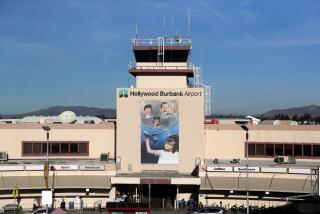Impasse Not Terminal
- Share via
Federal Aviation Administrator Jane Garvey’s prompt response to a near meltdown in negotiations over building a new terminal at Burbank Airport is promising. It shows the FAA’s commitment to finding a solution to a dispute that has dragged on for two decades. An agreement is finally, tantalizingly within reach. But it will take the cooperation of all sides to work out the details.
Achieving that cooperation will take strong leadership from the FAA. Garvey’s letter last week to Burbank Mayor Stacey Murphy is a start.
The letter was one of a flurry sent over the past few months. The sequence began late last year when Garvey wrote a letter to The Times responding to an editorial calling for more FAA guidance on the framework agreement between the city of Burbank and the airport authority.
Burbank officials took exception to Garvey’s letter, which was published in The Times, and on Feb. 3 Murphy wrote the airport authority and suspended negotiations. The suspension prompted Garvey to write Murphy.
Are you with us so far?
There is not much point to sorting out who’s right and who’s wrong in this round robin. The important thing is that Garvey in her letter to Murphy called for improving “direct lines of communication.”
Given the recent indirect lines of communication, surely everyone can agree on that.
Where should the process go from here?
Although we do not agree with Murphy’s characterization of Garvey’s original letter to The Times as an “unwarranted and irresponsible attack” on the framework agreement, we do agree that, at this point in the negotiations, the FAA needs to provide clear guidance on whether the hard-won agreement meets federal requirements.
If some areas do not, that doesn’t mean the entire agreement must be scrapped. But all sides have to be willing to look for alternative solutions.
Granted, straightforward answers don’t always stop the questions. The FAA has, for example, stated repeatedly that federal law prohibits both the city and the airport from imposing a unilateral curfew. This has not stopped die-hard airport opponents from calling for a curfew before any new terminal can be built, even one with the same number of gates as the old one.
In other words, the parties involved have to be ready to accept that an answer might be no.
The agreement attempts to get around the curfew by closing the terminal at night, making it inconvenient, but not impossible, to schedule nighttime arrivals or departures.
Is that legal?
If not, can the FAA persuade airlines to voluntarily accept a nighttime closure?
Can Burbank persuade homeowner groups to accept such an agreement?
We realize there is a certain amount of nuance to negotiations, and that some proposals--such as shuttering the terminal as a way to get around an outright curfew--have not been tried elsewhere. There may not be clear-cut answers.
We also realize that the agreement itself, and the language in which it is written, is especially sensitive because other cities across the country, and even other countries that have treaties with the United States, are watching. The FAA has to be careful about what precedents it sets.
But Garvey herself challenged the city and the authority to find a local solution. They did--in spite of challenges from die-hards on both sides who want to see the airport closed completely or expanded without limits. The pressure by these groups to scuttle any compromise is great.
To survive in any form, the agreement needs the FAA’s input. The success or failure of the effort itself will set a precedent.
After all, the rest of the country will be watching to see if the FAA, after pressing a community to find a local solution, will support its efforts to do so.
More to Read
Sign up for Essential California
The most important California stories and recommendations in your inbox every morning.
You may occasionally receive promotional content from the Los Angeles Times.













